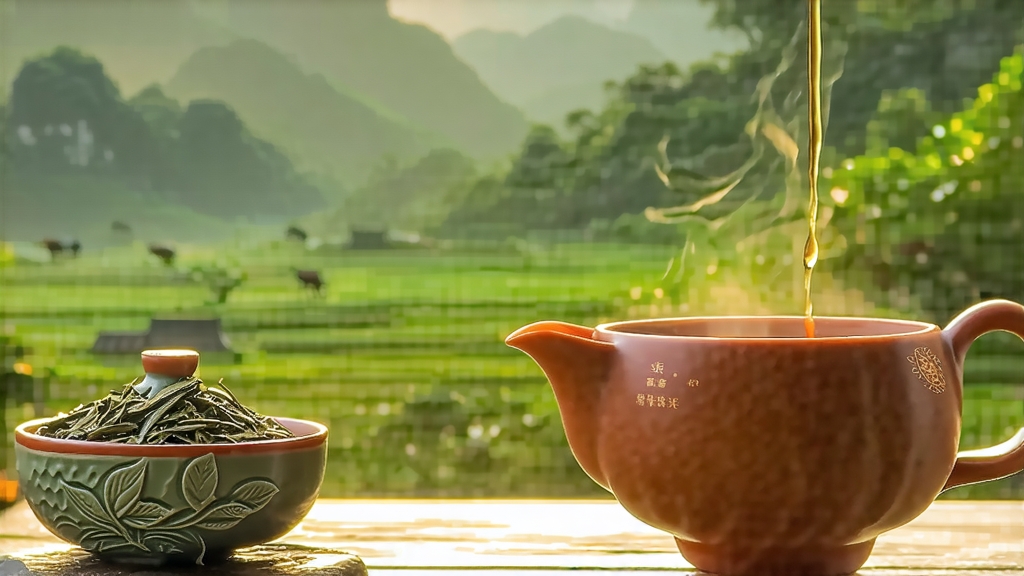
If green tea is the youthful scholar of Chinese tea and pu-erh the venerable sage, then Tie Guan Yin—literally “Iron Goddess of Mercy”—is the poised poet who balances freshness with depth, floral lift with mineral gravity. Among all oolong families, none has travelled so widely yet retained so intimate a bond with its birthplace: the granite-studded hills of Anxi in southern Fujian. To understand Tie Guan Yin is to witness how a single cultivar, processing style, and micro-climate can conspire to create a liquor that tastes like mountain mist, orchid, and warm stone all at once.
A legend carved in stone and fog
Local monks still recount the Qing-era tale of Wei Yin, a devout farmer who dreamt of Guanyin, the Bodhisattva of Compassion, leading him to a hidden shrub behind a rusted iron gate. Upon waking he found the plant, transplanted it to his courtyard, and discovered its leaves yielded an infusion of unparalleled fragrance. Whether myth or marketing, the story encodes two truths: the cultivar is indeed a genetic outlier—botanically classified as Tie Guan Yin “pure strain” (TGY #12)—and the iron-rich laterite soils of Anxi’s Xiping, Gande, and Longjuan townships give the tea its signature metallic snap on the finish. By the late 1980s Anxi growers had grafted this strain onto more vigorous rootstock, expanding acreage without diluting identity, and today 60 % of the county’s 40,000 hectares are planted in Tie Guan Yin.
From leaf to work of art: the 24-hour choreography
Unlike green tea that seeks to arrest oxidation or black tea that pursues full conversion, Tie Guan Yin dances in the 25–40 % oxidation band, a margin measured in heartbeats. Picking begins at dawn when two leaves and a bud still hold overnight dew; the goal is a semi-mature cell structure whose edges will bruise but not shatter. After solar withering under mesh canopies, the leaves are “shaken” in round bamboo tumblers—yao qing—where gentle collisions tear cortical walls, releasing enzymes that will later paint the cup in apricot and orchid. This shaking occurs five to seven times across the afternoon, each round separated by 45-minute rest periods during which the leaf “returns to life” (hui yang). Oxidation is finally fixed at 3 a.m. in drum roasters set to 260 °C for exactly three minutes; too short and the tea stays grassy, too long and the floral top notes collapse into generic roast. What follows is the craft’s most recognisable step: the 60-second high-temperature “wrap-rolling” (bao rou), where 15 kg of hot leaves are tied into a cotton cloth ball and tumbled in a motorized cage, compressing cells so that aromatic oils migrate to the surface. The cycle—roast, wrap, rest—is repeated three times, curling the leaf into the signature “dragonfly head, frog-leg” form. A final charcoal bake at 80 °C for six hours lowers moisture to 4 % while gifting a whisper of smoked honey that will re-awaken months later in the cup.
Styles: a spectrum of green, gold, and charcoal
Modern Tie Guan Yin is not one tea but three stylistic siblings. “Qing Xiang” (light fragrance) dominates export menus: pale jade liquor, snap-pea sweetness, and a cooling finish reminiscent of glacier water. “Nong Xiang” (traditional roast) is the older guardian—amber broth, toasted sesame nose, and a mineral tail that lingers like struck flint. Between them sits “Tuo Xiang” (moderate roast), a pragmatic compromise that keeps florals while adding baked-custard depth. A fourth, increasingly rare expression is “Laoren Tie Guan Yin,” aged in unglazed clay jars for fifteen years, re-roasted every spring; it steeps up dark mahogany with notes of dried longan, sandalwood, and the quiet serenity of temple incense.
Terroir in a cup: why Anxi tastes like no other
Anxi sits on the Tropic of Cancer, but 600–800 m elevations pull average temperatures down to 18 °C, slowing leaf growth and concentrating amino acids. Morning fog refracts sunlight into soft, blue-rich wavelengths that boost floral volatiles—linalool and geraniol